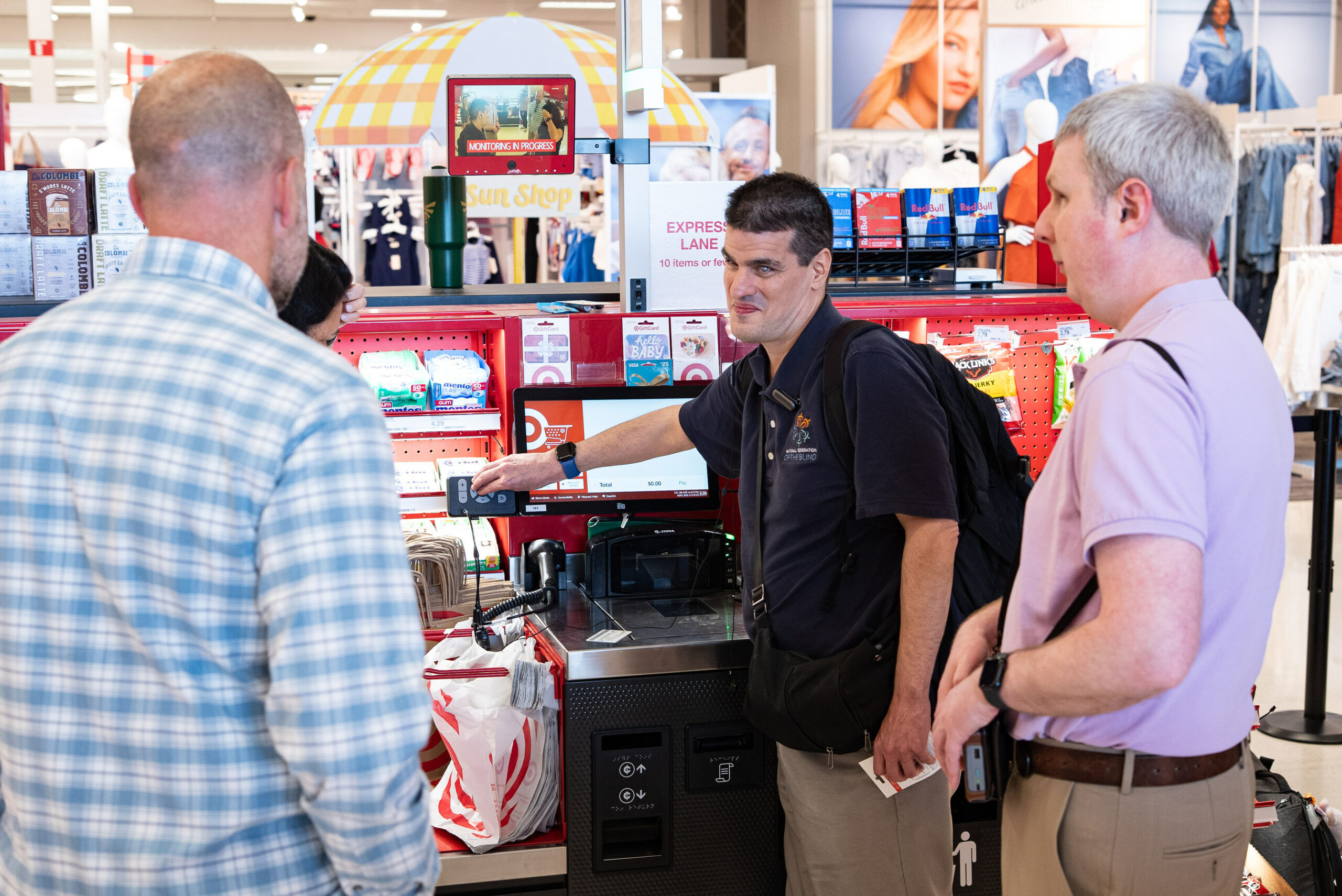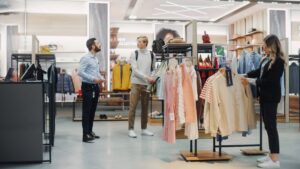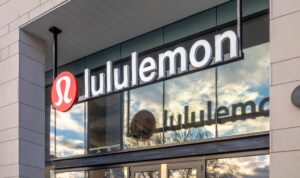
Photo courtesy of Target
September 29, 2025
How Important Is Accessibility in Retail?
While accessibility concerns are often spoken about by retail leadership figures, concrete plans to enhance accessibility for those facing unique challenges as consumers often fall short of the mark.
In the latest news, Target has announced what it is calling the “first-of-its-kind” accessible self-checkout experience, particularly aimed at those who may face hurdles when it comes to vision. The company noted that, as soon as this coming holiday season and continuing into 2026, this self-checkout experience will be installed in locations nationwide.
“This season brings so much joy for our guests, but we know it can be overwhelming, too. That is why even small wins matter — like an accessible self-checkout that helps guests shop their way, with confidence,” said Adrienne Costanzo, EVP and chief stores officer for Target, via a press release.
“Shopping with us should be easy, move fast and feel good — period,” she added.
The added tech seeks to enhance accessibility on certain checkouts, both for those who are blind or who have low vision, as well as those with motor disabilities. The integrated systems include: Braille and high-contrast button icons, a headphone jack with volume control, physical nav buttons and a standalone information key, a custom tactile controller, and an audio stream during scanning and payment.
“Target’s new accessible self-checkout experience is unique not only because it is a first in the industry, but because it was designed through collaboration with the blind, incorporating our technical expertise and lived experience,” said Mark Riccobono, president of the National Federation of the Blind.
“The rollout of this innovation further establishes Target as an industry leader in accessibility and a true partner of the blind in our quest for equal access to all aspects of modern life,” he added.
Target joins IKEA — which established a Digital Inclusive Design, Equity & Accessibility Centre of Expertise in 2021 — as well as other retailers in this broader movement.
What the Numbers Say About Accessibility and Inclusive Retail
According to some sources, an increased focus on accessibility in retail isn’t only about driving revenue: Per a Level Access survey, the top three reasons cited as to why professionals began prioritizing digital accessibility were: legal compliance (25%), improving usability for all (25%), and expanding revenue opportunities (19%). When it comes to the motive for the continuation of these priorities, the numbers looked somewhat similar: improving usability for all (29%), legal compliance (20%), and expanding revenue opportunities (19%).
And when it comes to strictly online shopping, Fable data indicated that — of those consumers who use assistive technologies — barriers remain. Citing Cloudwards figures, Fable noted that 50% persons with disabilities shop online for physical products on a weekly basis, versus just 22% of general consumers.
“But as the industry has expanded, has it abandoned its roots? Though originally intended to help people with disabilities, many disabled consumers find themselves increasingly frustrated, limited, and abandoned by the E-tail industry,” Fable’s intro to the study read.
While accessibility (frictionless experiences being key), variety (those facing disabilities being more keen to become expert in a single app versus navigating the idiosyncracies of many), and of course price being prime concerns for consumers who use assistive tech — and Amazon being cited as the top choice on these metrics — a vast majority (81%) of respondents indicated that they regularly experience frustrating accessibility issues. A quarter of those polled (27%) stated that accessibility issues force them to abandon a purchase at least once per month, with 8% saying that this occurs on a weekly basis.
“Sometimes the description of a product isn’t enough for me to determine if the product is what I need and almost all the time, product images are not described. Also, poorly coded webpages can make buying things frustrating because it takes a long time sometimes to figure out how to work around them,” user Ka L said.
“I’ve noticed many buttons don’t provide auditory feedback when I press them with my screen reader. If the button reads, ‘Place Order,’ it makes me even more nervous since I don’t want to accidentally order the same thing multiple times.” a second user, anonymized as Josh, added.
Discussion Questions
How much should retailers, both physical and digital, invest in improving accessibility infrastructure and protocols in their operations? Is cost-effectiveness a major stopping block?
Where can accessibility expenditures be most wisely allocated? Are any retailers or retail industries focusing on the wrong areas of improvement? If so, where could funds be better spent?
Speaking of the broader general consumer, will concrete appeals or improvements to accessibility and inclusivity by retailers drive improved spend?
Poll
BrainTrust
Gene Detroyer
Professor, International Business, Guizhou University of Finance & Economics and University of Sanya, China.
Scott Benedict
Founder & CEO, Benedict Enterprises LLC
Gary Sankary
Retail Industry Strategy, Esri
Recent Discussions







Catering for people with accessibility needs isn’t just about fairness, it’s also about commerciality. There are a huge number of Americans with various accessibility requirements, and they command a great deal of spending. Of course, engineering the proper solutions requires listening and learning directly from those affected.
It’s certainly a nice policy, and one that will become (somewhat) more important as the population ages, but I don’t see it being a strong differentiator; with regard to Target, in particular, the idea that this will reverse their fortunes is delusional.
The question of cost effectivenss has curious timing: traditonally “improvements” in security (like entry gates) or operations (greater self service) have seemed to come at the expense of accesability, but the latest changes – locked cabinets, eliminating self-scan – seem to benefit it.
Kudos to Target for its accessible self-checkout initiative. It sounds like it’s well-designed, thoughtfully executed, and will absolutely make a difference for blind and low-vision guests.
But let’s not lose sight: the Americans with Disabilities Act has been in force since 1990. It mandates accessibility in public accommodations—including retail. When I was laying out store fixtures at Target, we were legally required to meet standards for aisle width, product placement, signage, and check lanes. These weren’t just suggestions. They came with real capital costs and significant penalties for violations.
While self-checkout didn’t exist when the ADA was drafted, the spirit of the law is clear: if you build a new interface, it must be accessible. Target, to its credit, is getting ahead of that curve.
Accessibility in retail should be seen as both a moral responsibility and a smart business strategy. By making stores and digital platforms more inclusive, retailers not only serve customers with disabilities but also create better experiences for everyone. Clear navigation, intuitive layouts, accessible checkouts, and assistive features online all reduce friction and open the door to a broader customer base.
Cost-effectiveness is often cited as a barrier, but the most impactful improvements are often foundational rather than flashy. Prioritizing investments like staff training, accessible signage, and digital compliance standards delivers far greater returns than chasing “nice-to-have” features that don’t address core barriers. These changes directly reduce abandoned purchases and missed opportunities.
Importantly, accessibility resonates beyond those who rely on it most. Shoppers increasingly reward brands that demonstrate inclusivity, and improvements designed for accessibility often enhance usability for all. Retailers that treat accessibility as integral to customer experience—not a compliance checkbox—are more likely to see lasting loyalty and sales growth.
Accessibility often remains a “bolt-on” consideration because retail leadership still views it through a cost lens rather than a design lens. As Gary Sankary noted, ADA has been law since 1990, yet we’re celebrating Target’s 2025 self-checkout as “first-of-its-kind.” That 35-year gap between legal mandate and meaningful innovation reveals a systemic flaw.
For Tech companies that treated accessibility as “Phase 2” work, they consistently faced costly retrofitting. Companies that have adopted universal design principles from the outset, such as Apple’s VoiceOver and Microsoft’s inclusive design toolkit, have found that accessibility constraints often enhance the core product quality for everyone. Retailers who treat this as a compliance checkbox or a PR initiative will continue to lose revenue to competitors who understand that inclusive design is superior design.
This is a commendable move by Target. It raises the question: when will other major retailers follow suit in providing meaningful support to those who need it most?
Two comments. One, “bravo” for Target and those who have come before. Two, why has it taken so long? ATMs have had all these bells and whistles for a decade.
The reality is that as accessibility has increased in all phases of life, those in need are joining the activities of the general population more, and therefore, accessing retail activities that were previously avoided. While I am sorry to see legal compliance as one of the reasons for these improvements, I acknowledge that none of these would have progressed without the ADA. It would be ideal if the upgrades were made solely for good business and moral reasons. In any case, the trend is going in the right direction. Hopefully, it will continue.
Recent reports indicate that 1 in 4 Americans have some type of disability–ranging from cognitive to physical conditions. Which would indicate a huge market opportunity; however, retailers must proceed with caution before they make major investments in their stores as they would have to cater to a wide variety of conditions to address. The greater good here is to focus on the aging population that affects most consumers at some point. Seating areas, large font signage, audio price checks with type screens for reading, reachable inventory, etc. I would also recommend coming up with shopping baskets that hook onto walkers/wheelchairs so shoppers don’t have to just use the rolling carts for stability. The key caution here is that retailers cannont address every individual need, but to try and make their stores broadly accessible.
Accessibility includes the natural physical changes that happen as we all age. The accessibility mode in Google Maps can be used to avoid steep stairs while travelling. My eyesight isn’t what it once was, and the list goes on. The more accessible your product or service, the bigger your overall market.